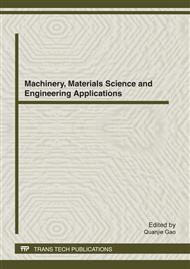p.298
p.304
p.310
p.316
p.322
p.328
p.334
p.340
p.345
Simulation and Experimental Study of the Coupling Drive Magnetic Field for Embedded Giant Magnetostrictive Actuators
Abstract:
Embedded giant magnetostrictive actuator (EGMA) is one of the most important applications of magnetostrictive material. Giant magnetostrictive actuators can deliver big-output displacement and can be driven at high frequencies. These characteristics make them suitable for a variety of positioning. However, because of the limitation of structure, the drive coil and EGMA cannot be any size as needed, so how to maximize the displacement in the limitative situation by optimization becomes the key of design. Several methods are available in the literature, but the coupling drive magnetic field of EGMA and its matrix material is often ignored. In fact, there was a close relationship between the matrix material and the distribution of drive magnetic field. To analyze the relationship, this paper establishes the magnetic circuit model for EGMA. The simulation of the coupling drive magnetic field is also presented. Finally the assumption is validated through experimental tests carried out with two different matrix materials.
Info:
Periodical:
Pages:
322-327
Citation:
Online since:
April 2012
Price:
Сopyright:
© 2012 Trans Tech Publications Ltd. All Rights Reserved
Share:
Citation:


